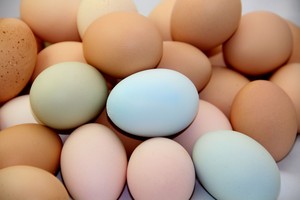Purchasing Eggs and Poultry
If you would like to purchase eggs, please contact usfor availability. Organic free range eggs: $8/dozen
As with every other aspect of our farm, we prefer our chickens to live as naturally as possible and provide an environment that allows them to be, well ... chickens. Not caged, not stressed, not bored. We find that chickens that have lots of room to explore and forage are happy, healthy and less aggressive towards each other. And their eggs taste great! The birds range freely among several large yards - fenced and with netting above to protect against predators. They enjoy munching on grass or digging for insects & seeds, or roosting in the shade trees. The coops stay open all day long so they can come and go as they please. We close up the coops at dusk for their own safety.
The birds range freely among several large yards - fenced and with netting above to protect against predators. They enjoy munching on grass or digging for insects & seeds, or roosting in the shade trees. The coops stay open all day long so they can come and go as they please. We close up the coops at dusk for their own safety.
We have never found it necessary to inoculate our birds and chicks are not debeaked - a procedure in which the beak is partially cut off to prevent the bird from harming itself or others. Stressed, caged chickens in factory-farm situations will often self-mutilate, picking out their feathers or wounding themselves.
We feed only organic commercial feed, along with fresh fruit & veggies from our garden. All birds are heritage breeds - hardy, intelligent and without the problems associated with the types of birds bred specifically for the factory farm system. Most are dual purpose; that is, they are good egg layers and also are large enough to be raised for meat.

Rhode Island Red x Rhode Island White (Reddish brown): This cross is called Red Sex Link. Prolific layers of brown eggs, 6 pound birds.
Ameraucana (Reddish brown): Dual purpose bird, 5.5-6.5 pounds. Produces eggs that are various shades of blue and green.
Chantecler (White & Partridge): Dual purpose bird 6.5-8 pounds with pale brown eggs. The only “Canadian” chicken. White Chantecler first developed in the early 1900s for winter hardiness, this chicken doesn’t have a large comb or wattles which can get frostbitten in sub-zero temperatures, and has a downy undercoat for extra insulation. Partridge Chantecler developed in the 1930s and not related to the White Chantecler even though they share the same name.